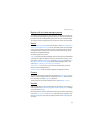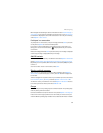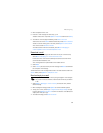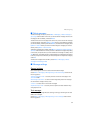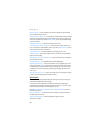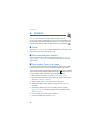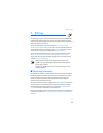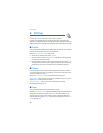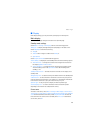
Messaging
39
Default slide timing — to define the default time between slides in
multimedia messages
Allow multimedia reception > Yes or No — to receive or block the multimedia
message. If you select In home network, you cannot receive multimedia messages
when outside your home network. The default setting of the multimedia message
service is generally In home network.
Incoming multi- media messages — to allow the reception of multimedia messages
automatically, manually after being prompted, or to decline the reception.
This setting is not shown if Allow multimedia reception is set to No.
Allow advertisements — to receive or decline advertisements. This setting is not
shown if Allow multimedia reception is set to No or Incoming multi- media
messages is set to Reject.
Configuration settings > Configuration — only the configurations that support
multimedia messaging are shown. Select a service provider, Default, or Personal
config. for multimedia messaging. Select Account and a multimedia messaging
service account contained in the active configuration settings.
E-mail messages
The settings affect the sending, receiving, and viewing of e-mail. You may receive
the settings as a configuration message. See “Configuration settings service,” p. 10.
You can also enter the settings manually. See “Configuration,” p. 58.
Select Menu > Messaging > Message settings > E-mail messages and from the
following options:
Configuration — to select the set that you want to activate
Account — to select an account provided by the service provider
My name — to enter your name or nickname
E-mail address — to enter your e-mail address
Incoming server type — to select the incoming e-mail server type
Login information — to enter information according to the server type
Incoming mail settings — to select the maximum number of mails that shall
be retrieved
Outgoing mail settings (SMTP) — to enter SMTP (simple mail transfer protocol)
information and setting options used when sending e-mail
Display terminal window > Yes — to perform manual user authentication for
intranet connections.



